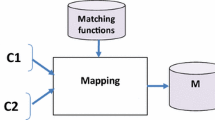Abstract
Conceptual Graphs are a very powerful knowledge and meaning representation formalism grounded on deep philosophical, linguistic and object oriented principles [1], [2]. Concerning geographic knowledge representation and matching, the study and analysis of geographic concept definitions plays an important role in deriving systematic knowledge about concepts and comparing geographic categories in order to identify similarities and heterogeneities [4]. Based on the proposed algorithm for the representation of geographic knowledge using conceptual graphs, we also present a method that takes into consideration the special structure of conceptual graphs and produces an output that shows how much similar two geographic concepts are and hence which concept is semantically closer to another. For producing the conceptual graph representation of any geographic concept definition we follow two steps, tagging and parsing, while for measuring the similarity between two geographic ontologies we apply proper modifications to the Dice coefficient that is mainly used for comparing binary structures.
This work extends the use of conceptual graphs in geographic knowledge representation as first introduced in [18]. It also addresses the issue of comparison.
Preview
Unable to display preview. Download preview PDF.
Similar content being viewed by others
References
Sowa, J.: Conceptual Structures: Information Processing in Mind and Machine. Addison-Wesley, Reading (1984)
Sowa, J.: Knowledge Representation: Logical, Philosophical and Computational Foundations. Brooks Cole Publishing Co. (2000)
Tepfenhart, W., Cyre, W.: Conceptual Structures: Standards and Practices. In: 7th Intl. Conf. Conceptual Structures. Springer, Blacksburg (1999)
Kavouras, M., Kokla, M., Tomai, E.: Determination, Visualization and Interpretation of Semantic Similarity among Geographic Ontologies. In: Gould, M., Laurini, R., Coulondre, S. (eds.) Proceedings of the 6th AGILE Annual Conference on Geographic Information Science, pp. 51–56. Presses Polytechniques et Universitaires, Romandes (2003)
Kuhn, W.: Modeling the Semantic of Geographic Categories through Conceptual Integration. In: Egenhofer, D., Mark, D. (eds.) Proceedings of the Second International Conference GIScience, pp. 108–118. Springer, Heidelberg (2002)
Kokla, M., Kavouras, M.: Extracting Latent Semantic Relations from Definitions to Disambiguate Geographic Ontologies. In: Zavala, G. (ed.) GIScience 2002 Abstracts. University of California Regents, pp. 87–90 (2002)
Conceptual Graph Standard. NCITS.T2 Committee on Information Interchange and Interpretation (2002)
Ellis, G., Lehmann, F.: Exploiting the Induced Order on Type-Labeled Graphs for fast Knowledge Retrieval. In: Tepfenhart, W., Dick, J., Sowa, J. (eds.) Conceptual Structures: Current Practices. LNCS (LNAI). Springer, Heidelberg (1994)
Huibers, T., Ounis, I., Chevallet, J.: Conceptual Graph Aboutness. In: Ekland, P., Ellis, G., Mann, G. (eds.) Conceptual Structures: Knowledge Representation as Interlingua. LNCS (LNAI). Springer, Heidelberg (1996)
Rasmussen, E.: Clustering Algorithms. In: Frakes, W., Baeza-Yates, R. (eds.) Information Retrieval: Data Structures and Algorithms. Prentice Hall, Englewood Cliffs (1992)
WordNet 2. A Lexical Database for the English Language. Cognitive Science Laboratory, Princeton University
Alshawi, H.: Analysing the Dictionary Definitions. In: Boguraev, B., Briscoe, T. (eds.) Computational Lexicography for Natural Language Processing, pp. 153–170. Longman Group UK Limited (1989)
Klavans, J., Chodorow, S., Wacholder, N.: From Dictionary to Knowledge Base via Taxonomy. In: Proceedings of the 6th Annual Conference of the UW Centre for the New OED: Electronic Test Research, pp. 110–132 (1990)
Montemagni, S., Vanderwende, L.: Structural Patterns vs. String Patterns for Extracting Semantic Information from Dictionaries. In: Proceedings of the 14th COLING, pp. 546–552 (1992)
Jensen, K., Binot, J.: Disambiguating prepositional phrase attachments by using on-line dictionary definitions. Computational Linguistics 13(3-4), 251–260 (1987)
Ravin, Y.: Disambiguating and Interpreting Verb Definitions. In: Jensen, K., Heidorn, E., Richardson, D. (eds.) Natural Language Processing: The PLNLP Approach. Kluwer Academic Publishers, Dordrecht (1993)
Vanderwende, L.: The Analysis of Noun Sentences using Semantic Information Extracted from on-line Dictionaries. PhD Thesis, Faculty of the Graduate School of Arts and Sciences. Georgetown University, Washington D.C. (1995)
Karalopoulos, A., Kokla, M., Kavouras, M.: Geographic Knowledge Representation Using Conceptual Graphs. In: 7th AGILE Conference on Geographic Information Science, Crete, Greece (2004)
Author information
Authors and Affiliations
Editor information
Editors and Affiliations
Rights and permissions
Copyright information
© 2005 Springer-Verlag Berlin Heidelberg
About this paper
Cite this paper
Karalopoulos, A., Kokla, M., Kavouras, M. (2005). Comparing Representations of Geographic Knowledge Expressed as Conceptual Graphs. In: Rodríguez, M.A., Cruz, I., Levashkin, S., Egenhofer, M.J. (eds) GeoSpatial Semantics. GeoS 2005. Lecture Notes in Computer Science, vol 3799. Springer, Berlin, Heidelberg. https://doi.org/10.1007/11586180_1
Download citation
DOI: https://doi.org/10.1007/11586180_1
Publisher Name: Springer, Berlin, Heidelberg
Print ISBN: 978-3-540-30288-9
Online ISBN: 978-3-540-32283-2
eBook Packages: Computer ScienceComputer Science (R0)




